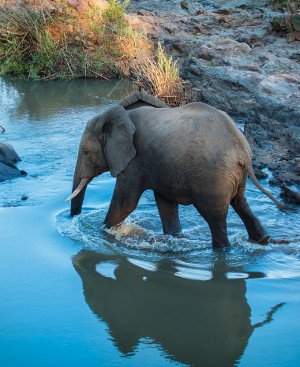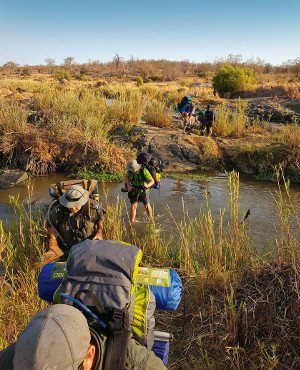Lonely Bull Trail Kruger National Park
Article from Wild Magazine Autumn 2018. By Hlengiwe Magagula
Over four days the Lonely Bull Trail in Kruger, citified backpackers tune in to their senses and learn some of the tracking skills that meant life or death to our ancestors.
The sands of the Letaba riverbed were dappled with spoor and dung. Frankly, it was a mess. But our guide saw it differently. Piet van der Merwe scanned the ground the way others read the news. This civet passed an hour or two ago on a dawn hunt. Here, a porcupine dragged its quills in the night. Beneath that slight track, the unmistakable pads of a giraffe that came to drink yesterday evening. As Piet talked, my imagination wandered. Once, my ancestors might have walked this river bank, in what is now Kruger National Park. They would have studied similar tracks with a life or death intensity, their wellbeing safeguarded by
constantly reading their landscape.
For me, learning some of these skills from our guides would be the most fascinating aspect of the four-day experience. We were beginning the Lonely Bull Backpacking Trail, in the heart of South Africa’s largest wildlife reserve. I was a bit apprehensive about the “backpacking” part, with visions of toiling in the sun under a heavy load. But I need not have worried. Our guides measured their days in tales told, not kilometres walked.
I began to think that we had two guides not just for safety, but to share the story-telling duties. Duncan Boustead, the assistant guide, showed us a way to count the number of persons in a group that has passed. Drawing two lines across the trail, a stride apart, he simply counted the footprints between. Repeated at a few different points, it gives a very accurate tally and is a technique used today when tracking poachers.

A walk on the wild side Backpackers fake a leaf out of an elephant’s book to wade through a stream. Photo Credits Barry Tanner
We moved on a little, and Piet poked a chalky pile with a stick. “Lion. Don’t touch these by hand,” he warned. “They can contain nasty stuff, worms and parasites.” He had no hesitation with herbivore droppings, picking them apart with his fingers to show us the clues that point to their creator. “See these twigs, how they’ve been cut at an angle? Sure sign of black rhino.” He explained that their white rhino cousins are grass grazers rather than tree browsers.
Hang on, did you say lion? I turned to scan the low Mopani forest that fringes the river. “Yes, they’re not far,” said Piet with enthusiasm. As the day was warming up, they’d probably retreated to a shady spot. For motorised visitors, this might be a typical lion sighting, a snoozing brown shape in the middle distance, perhaps the flick of a tail, half hidden in the grass. For us, it was different, as, on foot, we could actively seek them out. Piet knew where to look, so we tentatively approached some dense bushes amid the sandbanks. We found a perfect cat siesta spot, but there was nobody home, and perhaps that was for the best.
We set up camp overlooking the river, picking a site that was not an obvious elephant highway. Unlike Kruger’s popular Wilderness Trails, the Backpacking Trails, of which there are three, require guests to carry everything needed, including a tent, sleeping bag, stove and food. With the sun low, we found a shallow and safe spot in the river to bath. Duncan perched on a rock, keeping watch on a herd of elephants, just in case. Our drinking water also came from the river, with purification drops added.
After dark, as stoves boiled and fireflies danced, the stories continued. Other places, other trails. Close encounters and narrow escapes. Floods, droughts. Funny stories about treks past. I enjoyed the one about the guy with the enormous backpack, who carried everything possible. When the coffee was made, someone asked him for sugar, and he said, “Sure, white or brown?”, producing a half kilo of each!
I fell asleep to the sound of hippo squabbles. Next day, we were up before sunrise, eager to read the morning news in the sands. Less than 100 metres from the camp, we found more fresh lion spoor. They were tantalisingly close but out of sight. Duncan laid a stick between two prints, took a measure of the stride and raised the stick vertically, indicating a point above waist high. “That’s his shoulder height. He’s a big boy.”
We took off our shoes, and followed Piet across the braids of the river, searching out shallow sections. Suddenly, an explosion of water caused him to jump back sharply. There was a hippopotamus nearby, hidden by reeds. We took a little detour. Upriver, we were happy to sit for an hour within smelling distance of a pod of these grumpy beasts. Nearby, we watched a lone baboon make efforts to reach the nest of a goliath heron which contained a single chick. He had second thoughts when the enormous bird stretched to its full height and wingspan.
Like everyone who has walked this river for eons, we began to tune our senses for danger. A great cloud of dust rising ahead was the first sign of a buffalo herd approaching for water. One hundred, then two, three hundred at least. A strong breeze carried our scent to a family of elephants, which raised their trunks to sniff with apprehension. “They can’t see us,” said Piet, “and they don’t know how far we are. But they know we are here.” They retreated, having learnt that people can mean trouble, a huge bull taking up a defensive position behind his cows and calves. Definitely not the lonely bull.
By the last day, I’d stopped worrying about seeing lions or not. I was just happy to know they were out there, like the civet and porcupines, living their lives unbothered, less interested in us than we are in them. In a few days, our footprints would blur under hoof and paw, like those of all who walked here before.
Hlengiwe Magagula is a Swazi travel writer, and her work has appeared in Wild, Travel Africa and the Sunday Times. She is the author of Kruger to the Coast via Swaziland and her latest book is Guide to Walking in Kruger National Park.
www.amazon.com/Guide-Walking-Kruger-National-Park
Trip Planner
Explore Kruger on foot on one of the backpacking trails and pitch camp in a different spot each night. The Lonely Bull Backpacking Trail leaves from Mopani Rest Camp in Kruger National Park on Wednesdays and Sundays between 1 February and 30 November. Guests are expected to provide their own camping equipment and food for the duration of the trail. R2,950 a person, maximum eight.
Book with the trails reservations office 012 426 5111 www.sanparks.org
In addition to the Lonely Bull, hikers can choose from two further trails. The Olifants River Backpack Trail explores the landscape around Olifants Camp, a rocky area with magnificent large trees. The Mphongolo sets out from Shingwedzi Camp and traverses the wilderness area between the Shingwedzi and Mphongolo rivers.
Hikers must be fit enough to cover 10 to 15km a day, carrying a backpack with all their gear. Along with a tent and sleeping bag, trialists have to bring a gas stove. Trails take place in areas with water, but purification tablets and biodegradable soaps are essential.
Book your accommodation right here on ShowMe.
You can find the top hotels, lodges and Airbnb establishments conveniently placed on the map below. All you need to do is click on the place that’s conveniently located and within your budget and then make a booking. What could be easier?
If the map is not where you want to be, click on the ShowMe Pin and then enter the exact name of the location and the map will adjust accordingly.










